This was published 6 years ago
Israel and Palestine food tour: A Middle East feast
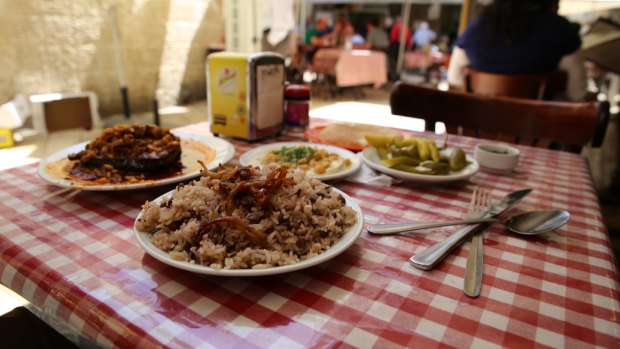
A dish of mujadara at Azura, Jerusalem.Credit: Ben Groundwater
With so many cultural influences to draw upon, with such a long history of gastronomic development to be affected by in this part of the world, it's a surprise to see the flavouring that Yahya is going for today: salt.
That's it. Just hot oil, and salt. He's smoking a cigarette as he fries the fish, humming words to the Arabic music that is pumped up loud in the background, sweating in his singlet as the seafood is tossed in hot oil, fried shatter-crisp, before being swung onto a plate and doused with a handful of salt. "It's ready," Yahya winks. "Get it out there!"
The dining room today is the great outdoors, a quiet alleyway in the port town of Acre in northern Israel. Every now and then a van needs to squeeze by, forcing us to pick up the plastic table and the ragtag chairs and hustle them in as close to the side of the road as we can while the driver and Yahya exchange friendly insults.
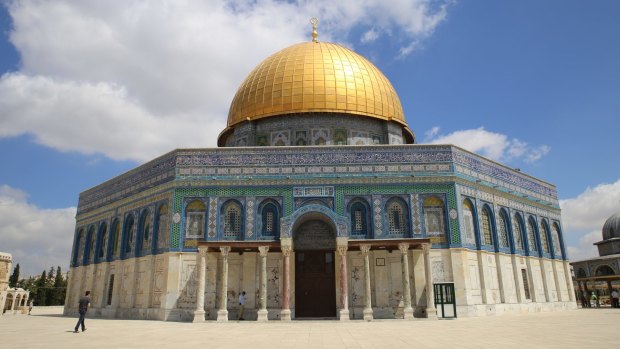
The Dome of the Rock in Jerusalem.Credit: Ben Groundwater
Already that table is laden with tasty goodness. There are bowls of fresh hummus swimming in olive oil. There are plates of pickled chillis, turnips and cucumbers. There's flatbread, Arabian style, chewy and delicious, making an absolute mockery of the old adage, "don't fill up on bread". Why wouldn't you? It's delicious.
But it's the fish that is the main attraction. An hour or so earlier, our guide on this Intrepid Travel tour of Israel and the Palestinian Territories, Mahdi, had ventured into Yahya's ramshackle old seafood shop next door to choose his favourite fish.
He'd opted for groper, sea bream and sardines, fresh from the Mediterranean, all of which were scaled, cleaned, and then carted over to Yahya's house next door for him to drown in that hot oil and shower with salt.
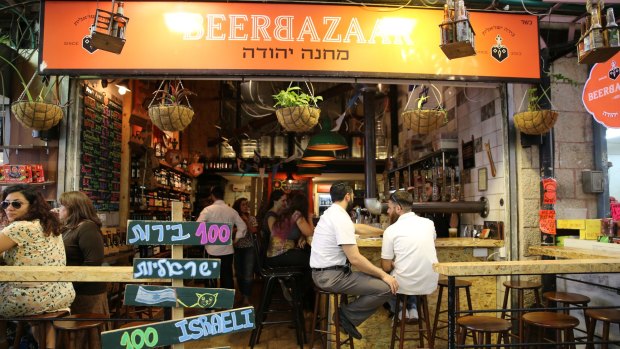
A craft beer bar at Mahane Yehuda Market, Jerusalem.Credit: Ben Groundwater
This is not a restaurant. We wouldn't be eating here unless Mahdi knew Yahya. But he does, and so here we are, a group of 10 strangers gathered in the alleyway outside Yahya's house, feasting on hot, crisp seafood, drinking arak, the anise-based spirit that Yahya loves, listening to Arabic music, chatting and enjoying the lazy afternoon.
Sometimes it's the simple things that are the best. Good company, good food. Today it's beautiful in its minimalism, yet Yahya's food is the product of a sophisticated and complex gastronomic culture that has been developed in this land over an incredibly long history.
In this ancient land, drawn today as Israel and the Palestinian Territories, you have a past that takes in so many of the world's great civilisations. The Romans, Greeks, Persians, Arabs, Ottomans, Assyrians, Israelites, Byzantines, Armenians and Russians – all have conquered this land or called it home. They've left their mark in various ways, from the ancient settlements of Jerusalem and Jericho, to the great religions that have dominated the world, to some of the best food around.
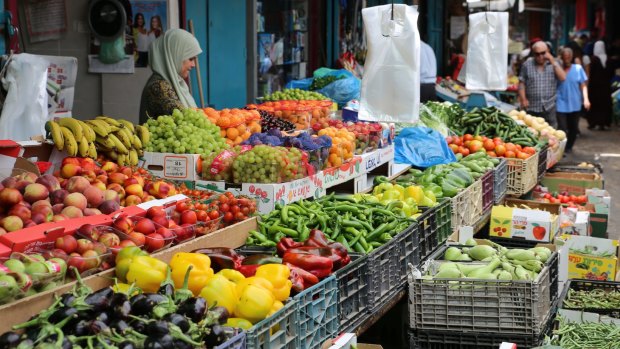
A market in Acre, Israel.Credit: Ben Groundwater
What is the cuisine of Israel and Palestine? Not so long ago, you wouldn't have heard much about it. Now, however, thanks to the likes of British-Israeli chef Yotam Ottolenghi, and universally popular dishes such as shakshuka, hummus and falafel, the world is taking notice. Enough notice, that is, for Intrepid Travel to launch a dedicated food tour of an area that is far better known for its religious tourism.
The cuisine of Israel and Palestine is far more than fried fish served in an Acre alleyway, as good as that is. This tour begins in Tel Aviv, Israel's vibrant hub, where food culture is as much about a "laffa", a greasy wrap of meat and salad eaten after a long night on the dance floor, as it is about fine dining. It's here we first try one of Israel's most famous exports, shakshuka, a dish of baked eggs that originated in Morocco, and is peddled today in the old port area of Jaffa.
Tel Aviv, cosmopolitan and cool, is an interesting introduction to Israel. It feels like it could be any beach town in the world; along the coastal promenade it's Rio de Janeiro, it's Sicily, it's Nice.

Sandals for sale in Nazareth.Credit: Ben Groundwater
An afternoon stroll here is accompanied by the staccato beat of wooden bats hitting rubber balls as beachgoers play "matkot", by the yell of kids in the water, by the murmur of music playing as groups gather around picnics in the sun.
This is just one part of a larger reality. This is a region that includes Jerusalem, ancient and battle-scarred. It's Haifa, traditional and pretty. It's Nazareth, it's Galilee. It's also the West Bank, cities such as Bethlehem and Nablus, places we will visit on this journey, and that will feel so different to the carefree vibe of Tel Aviv. All of these places, however, have something to offer, something to share.
In Haifa, the coastal city an hour north of Tel Aviv, we dine once again with locals, only this time with an Israeli called Erez, and his girlfriend, Mor. The pair are part of an Israeli-based program called "Eat With", the Uber or Airbnb of restaurants, where regular people put on dinner parties and locals and travellers can pay to attend.
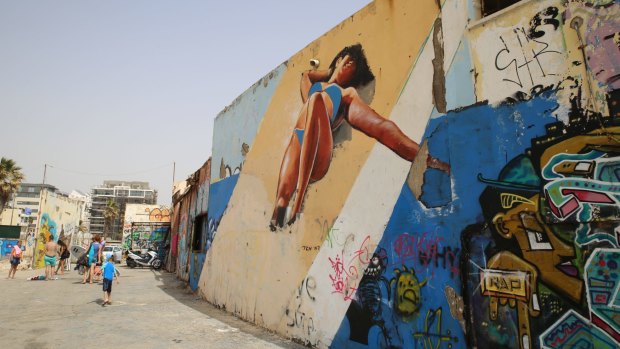
Street art in Tel Aviv.Credit: Ben Groundwater
During the day Erez is a fashion designer; by night, he's an amateur chef. Mor, meanwhile, is a sommelier by day, and a sommelier by night. The pair are easy-going and friendly, welcoming guests into their apartment, serving up Mediterranean-style food and good wine.
This is the sort of thing that makes this tour great: the interactions with normal people, the chance to put faces and names and personalities to this confusing and contentious land. Suddenly, Israel and Palestine are more than just a news story. They're Erez and Mor, charming and friendly. They're Yahya and his fried fish.
They're also Nahed, a member of the Druze faith, whose house we visit way up in the town of Buqata, in the Golan Heights.
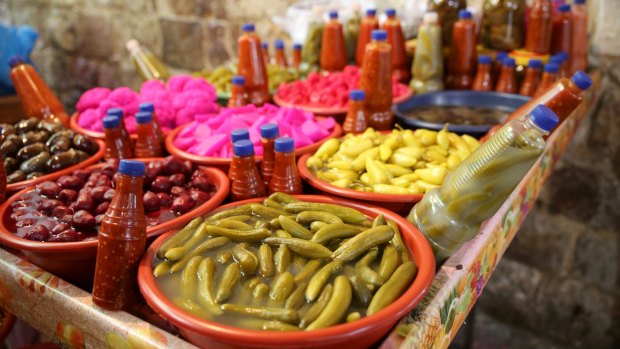
Pickled vegetables for sale on the streets of Nablus.Credit: Ben Groundwater
The Druze are Arabic speakers, though they live in closed communities, with members restricted to marrying and socialising with other Druze people. It's a treat, therefore, to be invited into Nahed's house, to sit at her table and eat mujaddara, a stew of rice and lentils.
There is such a huge cultural and political divide between Nahed and her family and this group of Anglo-Saxon tourists, and yet we find common ground over a love of food, and a shared curiosity. Nahed's teenage son has been sitting next to me on the carpet, cross-legged and quiet – so quiet I'm not even sure he speaks English – for an hour or so before he turns and points at the sunglasses on my head.
"Are they real Ray-Bans?"
"Yeah," I reply.
He nods. "Cool."
In the town of Nablus, in the West Bank, we meet more of the people who make up the intricate tapestry of life in this part of the world. At Bait al-Karama, a cooking school and Slow Food Movement centre run entirely by Palestinian women, we meet people such as Salaam and Fatimah, locals who want to share a culture, as well as a cuisine.
In Taybeh we meet Madees, Christian, female, and head brewer at Palestine's most popular microbrewery. In Bethlehem we chat to Zouzou, an Armenian-Palestinian and maker of the finest shish kebabs in the city.
In Jerusalem, historic, beautiful Jerusalem, we meet a whole team of Arabs who do a fine trade in hummus and falafel, those two delicious staples. In some ways it's the food that binds all of these experiences together, that helps give an understanding of Israel and the Palestinian Territories as a whole.
But really, as amazing as the food is, this cuisine is really just a conduit, a way of introducing us to the people who make it, the people who represent all the different sides of this complicated and fascinating place.
We learn their history and their culture, we share their humour and their food. And we also learn their shared secret: just add salt.
FIVE MUST-TRY DISHES
HUMMUS
You think you've tried this dish before, ground chickpeas blended with tahini, olive oil and lemon juice, but wait until you try around here. Served warm and fresh with minced lamb on top, it's just about the best thing in the world. Give it a go in East Jerusalem.
MUJADDARA
This is another of those simple dishes that is far greater than the sum of its parts. Lentils are cooked with rice in a rich stock before being served with sweetly caramelised onions. Sample it at Azura in the Jerusalem markets.
SHAKSHUKA
The baked egg dish that has become so popular in Australian cafes originated in Morocco, though it has since been adapted to Israeli tastes. Tomatoes are cooked with capsicum, onion and spices before a few eggs are cracked in and the whole lot goes in the oven. Try it at Dr Shakshuka in Tel Aviv.
MANAEESH
The Palestinians have their own version of the Lebanese-style flatbread known as manoosheh, cooked in a piping-hot wood oven and slathered in cheese, or zaatar, or even more deliciously, both. Best place to find it is in the streets of Nablus.
SHAWARMA
There are few things that can top a good, fresh shawarma – lamb or chicken cooked on skewers over hot coals before being sliced and rolled in flatbread with tabbouleh (parsley salad) and fattoush (cucumber and tomato), drizzled with tahini and hummus, and then devoured. The shops of Nazareth do an excellent version.
FLY
Singapore Airlines has codeshare flights with Turkish Airlines from major Australian ports to Tel Aviv, via Singapore and Istanbul. See singaporeair.com
TOUR
Intrepid Travel's 10-day Real Food Adventure of Israel and the Palestinian Territories starts from $3850 a person, and includes accommodation, some meals, transport by private vehicle, the services of a qualified guide, and entry into many historic and cultural sights. See intrepidtravel.com
SAFETY
Australian passport holders can enter Israel without a visa, although check Smart Traveller for the latest updates. The Australian Department of Foreign Affairs recommends travellers to Israel exercise a "high degree of caution", while they should reconsider their need to travel to the West Bank. See smartraveller.gov.au
Ben Groundwater travelled as a guest of Intrepid Travel.
Sign up for the Traveller Deals newsletter
Get exclusive travel deals delivered straight to your inbox. Sign up now.